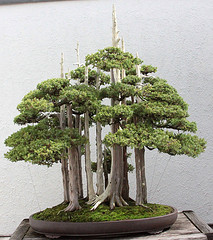
flickr.com/33590535@N06
Fascinated in growing your own bonsai? The initial step is to choose the right kind of plant.
The junipers is a coniferous evergreen shrub found in abundance in mountains and dry forests across the world. Juniper leaves are needle-like when tender but become scaly as the tree matures. Its foliage is generally light green to blue-green with occasional shades of silver. There are over 50 species of Juniper, but the most famous — juniper bonsai — are found primarily in Japan.
In fact, some juniper bonsai live for 200 years. Others die within 2 or 3 years of being turned into bonsai. The Chinese juniper, is the classic juniper bonsai, a natural hybrid species called Juniperus X media.
The juniper is fairly disease free and thrives best in full sun. However, it needs to be protected from the very hot sun at midday and from frost during extreme winters. Being kept indoors, poor humidity and bad lighting kills junipers, and over watering causes root to decay. For repotted plants, however, misting is best and can help avoid root problems. Misting also removes the dust that collects on top of leaves, which usually blocks the plant’s pores.
Junipers should be provided with a high-nitrogen fertilizer every two weeks from spring to mid-summer, followed by low-nitrogen feed through until winter. This should be swapped with an acidic fertilizer (such as Miracid) for best results.
Additionally, the plant should be repotted about once every two years until the age of ten. The repotting should happen during spring using only free-draining soil. The soil should include clean grit or clay so that alkaline deposits don’t damage the plant.
Junipers can be shaped through by being carefully pinched back through the growing season. The pinching should be performed with your fingers, and not by scissors, otherwise ends that were cut will turn brown. Keep in mind that enough foliage should be left on the plant to protect the branches from withering. Pinching should be gradual, and should never be done on young leaves that are merely sprouting. Also, there must be plenty of time between pinching activities.
Interestingly, for a few weeks after dying, junipers keep their natural shape. At times, this can make it difficult to distinguish a living juniper from a dead one.
Tagged with: growing bonsai • landscaping ideas
Filed under: Landscaping
